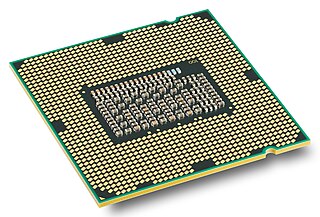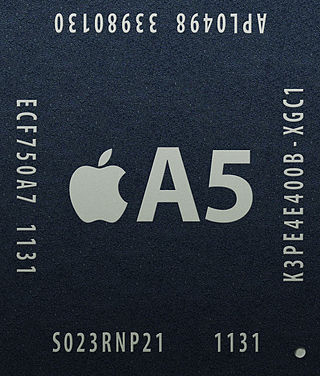PowerVR is a division of Imagination Technologies that develops hardware and software for 2D and 3D rendering, and for video encoding, decoding, associated image processing and DirectX, OpenGL ES, OpenVG, and OpenCL acceleration. PowerVR also develops AI accelerators called Neural Network Accelerator (NNA).

Sandy Bridge is the codename for Intel's 32 nm microarchitecture used in the second generation of the Intel Core processors. The Sandy Bridge microarchitecture is the successor to Nehalem and Westmere microarchitecture. Intel demonstrated a Sandy Bridge processor in 2009, and released first products based on the architecture in January 2011 under the Core brand.

AMD Accelerated Processing Unit (APU), formerly known as Fusion, is a series of 64-bit microprocessors from Advanced Micro Devices (AMD), combining a general-purpose AMD64 central processing unit (CPU) and 3D integrated graphics processing unit (IGPU) on a single die.

The Apple A4 is a 32-bit package on package (PoP) system on a chip (SoC) designed by Apple Inc. and manufactured by Samsung. It was the first SoC Apple designed in-house. The first product to feature the A4 was the first-generation iPad, followed by the iPhone 4, fourth-generation iPod Touch, and second-generation Apple TV.

The Apple A5 is a 32-bit system on a chip (SoC) designed by Apple Inc. and manufactured by Samsung. The first product Apple featured an A5 in was the iPad 2. Apple claimed during their media event on March 2, 2011 that the ARM Cortex-A9 central processing unit (CPU) in the A5 is up to two times faster than the CPU in the Apple A4, and the PowerVR SGX543MP2 graphics processing unit (GPU) in the A5 is up to nine times faster than the GPU in the A4. Apple also claimed that the A5 uses the same amount of power as the A4.

Apple silicon is a series of system on a chip (SoC) and system in a package (SiP) processors designed by Apple Inc., mainly using the ARM architecture. It is the basis of most new Mac computers as well as iPhone, iPad, iPod Touch, Apple TV, and Apple Watch, and of products such as AirPods, HomePod, HomePod Mini, and AirTag.

Ivy Bridge is the codename for Intel's 22 nm microarchitecture used in the third generation of the Intel Core processors. Ivy Bridge is a die shrink to 22 nm process based on FinFET ("3D") Tri-Gate transistors, from the former generation's 32 nm Sandy Bridge microarchitecture—also known as tick–tock model. The name is also applied more broadly to the Xeon and Core i7 Ivy Bridge-E series of processors released in 2013.

The Apple A5X is a 32-bit system on a chip (SoC) designed by Apple Inc. and manufactured by Samsung. Apple used it only in the third-generation iPad. The A5X is a high-performance variant of the Apple A5. Apple claimed during their media event on March 7, 2012 that the quad-core PowerVR SGX543MP4 graphics processing unit (GPU) in the A5X is two times faster than the GPU in the A5, as the A5X GPU contains two more cores than the dual-core version GPU in the A5.

The Apple A6 is a 32-bit package on package (PoP) system on a chip (SoC) designed by Apple Inc. that was introduced on September 12, 2012 at the launch of the iPhone 5. Apple states that it is up to twice as fast and has up to twice the graphics power compared with its predecessor, the Apple A5. Software updates for devices using this chip ceased in 2019, with the release of iOS 10.3.4 on the iPhone 5 as it was discontinued with the release of iOS 11 in 2017.
The Apple A7 is a 64-bit system on a chip (SoC) designed by Apple Inc. It first appeared in the iPhone 5S, which was announced on September 10, 2013, and the iPad Air and iPad Mini 2, which were both announced on October 22, 2013. Apple states that it is up to twice as fast and has up to twice the graphics power compared to its predecessor, the Apple A6. It is the first 64-bit SoC to ship in a consumer smartphone or tablet computer. On March 21, 2017, the iPad mini 2 was discontinued, ending production of A7 chips. The latest software update for systems using this chip was iOS 12.5.7, released on January 23, 2023, as they were discontinued with the release of iOS 13 and iPadOS 13 in 2019.

The iPad is a tablet computer produced and marketed by Apple Inc. Compared to its predecessor, the third-generation iPad, the fourth-generation iPad maintained the Retina Display but featured new and upgraded components such as the Apple A6X chip and the Lightning connector, which was introduced on September 12, 2012. It shipped with iOS 6, which provides a platform for audio-visual media, including electronic books, periodicals, films, music, computer games, presentations and web content. Like the third-generation iPad it replaced, it was supported by five major iOS releases, in this case iOS 6, 7, 8, 9, and 10. iOS 11, which was released on September 19, 2017, does not support the fourth-generation iPad as that update does not support 32-bit devices and apps.

The Motorola RAZR i (XT890) is a smartphone designed by Motorola Mobility. It was officially announced on 18 September 2012 in London, UK.
The Apple A8 is a 64-bit ARM-based system on a chip (SoC) designed by Apple Inc. It first appeared in the iPhone 6 and iPhone 6 Plus, which were introduced on September 9, 2014. Apple states that it has 25% more CPU performance and 50% more graphics performance while drawing only 50% of the power of its predecessor, the Apple A7. The latest software updates for the 1.1GHz and 1.4GHz variants systems using this chip are iOS 12.5.6, released on August 31, 2022 as they were discontinued with the release of iOS 13 in 2019, and 1.5GHz variant for the iPad Mini 4 is iPadOS 15.7.1, released on October 27, 2022 as it was discontinued with the release of iPadOS 16 in 2022, while updates for the 1.5GHz variant continue for Apple TV HD. The A8 chip was discontinued on October 18, 2022, following the discontinuation of the Apple TV HD.

The Apple A8X is a 64-bit ARM-based system on a chip (SoC) designed by Apple Inc. and manufactured by TSMC. It first appeared in the iPad Air 2 and only is used in the iPad Air 2, which was announced on October 16, 2014. It is a variant of the A8 inside the iPhone 6 family of smartphones and Apple states that it has 40% more CPU performance and 2.5 times the graphics performance of its predecessor, the Apple A7. The latest software update for the iPad Air 2 using this chip was iPadOS 15.7.3, released on January 23rd 2023 as it was discontinued with the release of iPadOS 16 in 2022 due to hardware limitations of the A8X.

The Apple A9 is a 64-bit ARM-based system-on-chip (SoC), designed by Apple Inc. Manufactured for Apple by both TSMC and Samsung, it first appeared in the iPhone 6S and 6S Plus which were introduced on September 9, 2015. Apple states that it has 70% more CPU performance and 90% more graphics performance compared to its predecessor, the Apple A8. On September 12, 2018, the iPhone 6S and iPhone 6S Plus along with the first-generation iPhone SE was discontinued, ending production of A9 chips. The latest software updates for the iPhone 6S & 6S Plus including the iPhone SE 1st generation variants systems using this chip are iOS 15.7.3, released on January 23, 2023 as they were discontinued with the release of iOS 16 in 2022, while updates for the iPad variants systems using this chip are still supported.

The Apple A9X is a 64-bit ARM architecture-based system on a chip (SoC) designed by Apple Inc. It first appeared in the iPad Pro, which was announced on September 9, 2015 and was released on November 11, 2015. The A9X has the M9 motion coprocessor embedded in it, something not seen in previous chip generations. It is a variant of the A9 and Apple claims that it has 80% more CPU performance and twice the GPU performance of its predecessor, the A8X.

The Apple A10 Fusion is a 64-bit ARM-based system on a chip (SoC), designed by Apple Inc. and manufactured by TSMC. It first appeared in the iPhone 7 and 7 Plus which were introduced on September 7, 2016, and is used in the sixth generation iPad, seventh generation iPad, and seventh generation iPod Touch. The A10 is the first Apple-designed quad-core SoC, with two high-performance cores and two energy-efficient cores. Apple states that it has 40% greater CPU performance and 50% greater graphics performance compared to its predecessor, the Apple A9. The Apple T2 chip is based on the A10. On May 10, 2022, the iPod Touch 7th generation was discontinued, ending production of A10 Fusion chips. The latest software updates for the iPhone 7 & 7 Plus including the iPod Touch 7th generation variants systems using this chip are iOS 15.7.3, released on December 13, 2022 as they were discontinued with the release of iOS 16 in 2022, while updates for the iPad variants systems using this chip are still supported.

The Apple A10X Fusion is a 64-bit ARM-based system on a chip (SoC) designed by Apple Inc. and manufactured by TSMC. It first appeared in the 10.5" iPad Pro and the second-generation 12.9" iPad Pro, which were both announced on June 5, 2017. The A10X is a variant of the A10 and Apple claims that it has 30 percent faster CPU performance and 40 percent faster GPU performance than its predecessor, the A9X.

The Apple A15 Bionic is a 64-bit ARM-based system on a chip (SoC) designed by Apple Inc. It is used in the iPhone 13 and 13 Mini, iPhone 13 Pro and 13 Pro Max, iPad Mini, iPhone SE, iPhone 14 and 14 Plus and Apple TV 4K.

iPhone and iPod Touch models released between 2007 and 2009 used system on a chip (SoC) circuits designed by Samsung and manufactured to Apple's specifications. Two such SoCs were used: the Samsung S5L8900, used in the first-generation iPhone, the iPhone 3G, and the first-generation iPod Touch, and the Samsung S5L8920, used in the iPhone 3GS and the third-generation iPod Touch. Both chips belong to Samsung's S5L family of SoCs.

















